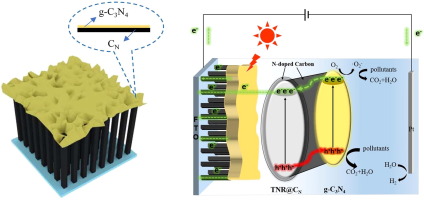当前位置:
X-MOL 学术
›
Appl. Surf. Sci.
›
论文详情
Our official English website, www.x-mol.net, welcomes your
feedback! (Note: you will need to create a separate account there.)
TiO2 Nanorod Arrays Decorated by Nitrogen-doped Carbon and g-C3N4 with Enhanced Photoelectrocatalytic Activity
Applied Surface Science ( IF 6.3 ) Pub Date : 2020-07-01 , DOI: 10.1016/j.apsusc.2020.146219 Kelei Huang , Chunhu Li , Xiuli Zhang , Xiangchao Meng , Liang Wang , Wentai Wang , Zizhen Li
Applied Surface Science ( IF 6.3 ) Pub Date : 2020-07-01 , DOI: 10.1016/j.apsusc.2020.146219 Kelei Huang , Chunhu Li , Xiuli Zhang , Xiangchao Meng , Liang Wang , Wentai Wang , Zizhen Li

|
Abstract A novel route was proposed for constructing nitrogen-doped carbon (CN) interfacial nano-layer derived from polydopamine to anchor graphitic carbon nitride (g-C3N4) onto TiO2 nanorod arrays (TNR) via solvothermal growth and annealed process. The prepared TNR@CN-C3N4/FTO photoanode with shell-core heterostructure exhibited the excellent visible light photosensitization and significantly enhanced photoelectrocatalytic (PEC) degradation of pollutant. The results of characterizations and photoelectrochemical measurements proved that CN bonded with TiO2 via C-O-Ti to enrich the absorption of visible light. In addition, CN reinforced the contact between TiO2 and g-C3N4, and improved the electrical conductivity. These synergistic effects resulted in the acceleration of photoexcited electrons separation/transfer and reactive species production. Ternary TNR@CN-C3N4/FTO photoelectrode showed the highest photocurrent density (0.45 mA/cm2 at 0.6 V) and the best PEC degradation rate (94.2% at 1.5 V) of methyl orange, which were higher than that of TNR-C3N4/FTO without CN layer by a factor of 2.4 and 0.3, respectively. It was proved that the holes were the main reactive species in PEC degradation. This work provided a new pathway for the development of g-C3N4 based heterostructure in photoelectrocatalytic removal pollutants.
中文翻译:

由氮掺杂碳和 g-C3N4 装饰的具有增强光电催化活性的 TiO2 纳米棒阵列
摘要 提出了一种构建源自聚多巴胺的氮掺杂碳 (CN) 界面纳米层的新途径,通过溶剂热生长和退火工艺将石墨氮化碳 (g-C3N4) 锚定到 TiO2 纳米棒阵列 (TNR) 上。制备的具有壳核异质结构的 TNR@CN-C3N4/FTO 光阳极表现出优异的可见光光敏化和显着增强的光电催化(PEC)降解污染物。表征和光电化学测量的结果证明,CN 通过 CO-Ti 与 TiO2 结合,从而丰富了对可见光的吸收。此外,CN加强了TiO2和g-C3N4之间的接触,提高了导电性。这些协同效应导致光激发电子分离/转移和反应物种产生的加速。三元TNR@CN-C3N4/FTO光电极表现出甲基橙的最高光电流密度(0.45 mA/cm2,0.6 V时)和最佳PEC降解率(1.5 V时94.2%),高于TNR-C3N4/无 CN 层的 FTO 分别为 2.4 和 0.3 倍。证明空穴是PEC降解的主要反应物种。这项工作为开发基于 g-C3N4 的异质结构在光电催化去除污染物中提供了新的途径。
更新日期:2020-07-01
中文翻译:

由氮掺杂碳和 g-C3N4 装饰的具有增强光电催化活性的 TiO2 纳米棒阵列
摘要 提出了一种构建源自聚多巴胺的氮掺杂碳 (CN) 界面纳米层的新途径,通过溶剂热生长和退火工艺将石墨氮化碳 (g-C3N4) 锚定到 TiO2 纳米棒阵列 (TNR) 上。制备的具有壳核异质结构的 TNR@CN-C3N4/FTO 光阳极表现出优异的可见光光敏化和显着增强的光电催化(PEC)降解污染物。表征和光电化学测量的结果证明,CN 通过 CO-Ti 与 TiO2 结合,从而丰富了对可见光的吸收。此外,CN加强了TiO2和g-C3N4之间的接触,提高了导电性。这些协同效应导致光激发电子分离/转移和反应物种产生的加速。三元TNR@CN-C3N4/FTO光电极表现出甲基橙的最高光电流密度(0.45 mA/cm2,0.6 V时)和最佳PEC降解率(1.5 V时94.2%),高于TNR-C3N4/无 CN 层的 FTO 分别为 2.4 和 0.3 倍。证明空穴是PEC降解的主要反应物种。这项工作为开发基于 g-C3N4 的异质结构在光电催化去除污染物中提供了新的途径。











































 京公网安备 11010802027423号
京公网安备 11010802027423号